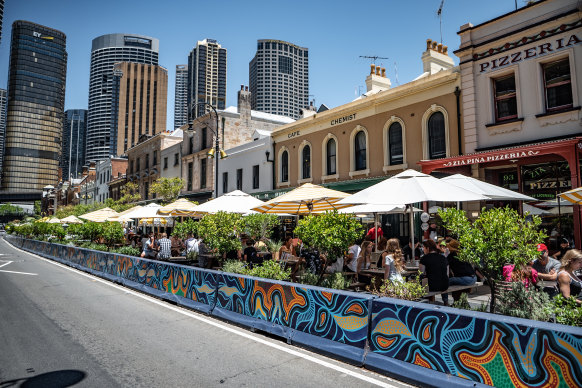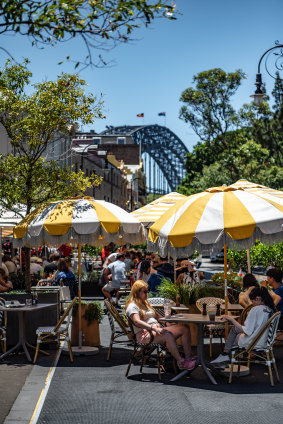George Street in the Rocks will become a permanent pedestrian and outdoor dining zone as the state government pushes forward with attempts to revamp Sydney’s public spaces following a string of successful revitalisation programs that have re-energised city streets since the pandemic.
Foot traffic in the city heritage precinct has reached 90 per cent of pre-COVID-19 levels despite fewer international tourists, but business turnover has risen more than 15 per cent on previous figures with the expansion of al fresco drinking and dining options along the road.

More streets will become permanent pedestrian zones with al fresco dining including George Street in The Rocks.Credit: Flavio Brancaleone
The government poured $66 million into street-based programs – including the al fresco dining package and streets as shared places initiative – in 112 council areas between May 2020 and December 2022, with the hope of reviving the city and helping businesses through years of uncertainty.
While CBD office occupancy rates are still just 59 per cent and some of Sydney’s high streets struggle with zombie shopfronts, a Transport for NSW report prepared for the end of the year has pointed to the programs’ success: more than half a million people across the state took part in various initiatives while the equivalent of 4000 car park spaces were returned to the public.
Its analysis also estimates 13,500 people were engaged in more than 300 local projects, with 2800 hospitality workers and 3300 creative workers employed.
Kiersten Fishburn, the transport department’s deputy secretary for its new cities and active transport division, said the evaluation was “evidence that we can and should reimagine what our places, streets and open spaces can look like”.
The shared streets program, for example, prompted councils to trial street closures, add public art, convert car parks, introduce cycleways, widen footpaths and green their spaces. Ninety per cent of those projects have retained key elements afterwards.
In Parramatta, Phillip Lane was improved with lighting, plants, live music and additional dining spaces over eight weekends, which participating businesses said contributed 30 per cent to sales and allowed them to employ up to two extra staff on event days. The council will seek to make some of those factors permanent.
And in the regional town of Griffith, a community-led street revival project that involved an interactive art installation created by local artists will also be kept permanently.

Foot traffic in The Rocks has reached 90 per cent of pre-COVID-19 levels.Credit: Flavio Brancaleone
The separate open streets program – which temporarily closed city streets for a day so people and businesses could spill out onto the road, and saw a spontaneous street party erupt in Surry Hills – boosted visitation to local areas by about 370 per cent and doubled business’ sales turnover.
Cities Minister Rob Stokes said the temporary and permanent measures introduced since 2020 had transformed the way Sydney and the state’s town centres used streets and public spaces.
“The pandemic accelerated global trends that were already happening, and we had to change too, transforming our central business districts into central social districts that encourage people to stay longer and spend local,” Stokes said.
“That’s why we threw out the rule book, closing off NSW streets to cars and opening them up to people, creating thousands of jobs for the hospitality industry and bringing joy to millions who attended events or enjoyed a meal or a drink outside.”
The programs were also paired with legislative changes; the state’s productivity commissioner recommended that a raft of relaxed rules for outdoor dining, takeaway alcohol services and food trucks, which were introduced during the pandemic, should stay to boost the economy.
Customer Service Minister Victor Dominello said the changes were introduced to support businesses through dark times but had ultimately made life better. He highlighted the al fresco dining program as an example of an improved way to regulate, with 200 venues receiving outdoor dining approval within days.
“What used to take up to 50 days, was cut to three days so both businesses and customers can take advantage of enjoying a meal and a drink on the street,” he said.
Stokes, who will retire from state parliament in March, said a good city was like a good party - which was why the government wanted to make several changes permanent and would be pedestrianising George Street at the Rocks for good.
Works to trial a pedestrian zone in George Street, between Hunter Street and Bridge Street, will also begin next month and create almost 6000 additional square metres of public space. The City of Sydney wants that change to become permanent by the end of 2023, to continue the pedestrianisation of the street’s south.
The Morning Edition newsletter is our guide to the day’s most important and interesting stories, analysis and insights. Sign up here.